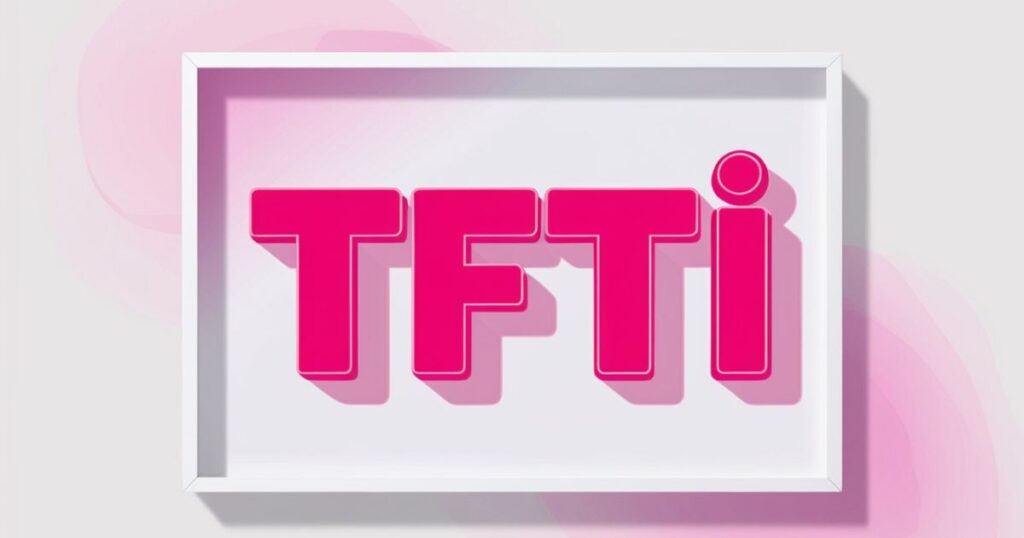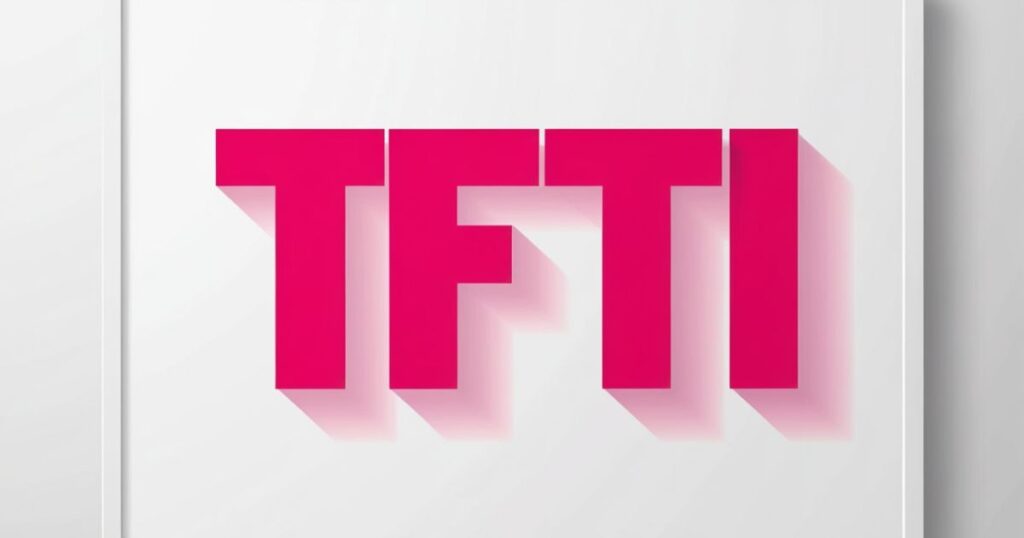Digital communication continues to evolve with new acronyms and internet slang appearing regularly. If you have encountered a message containing “TFTI” and wondered about its significance, you are not alone. This texting acronym carries particular weight in modern communication slang and understanding its proper usage is essential for effective digital interactions.
This comprehensive guide will examine the TFTI full form, explore its various applications, and provide professional alternatives for different communication contexts. Whether you need polite responses to invitations or seek to understand digital slang meanings, this analysis covers all essential aspects.
What Does TFTI Mean?
TFTI Definition
TFTI represents “Thanks for the invite” in text message lingo. This acronym TFTI explained reveals its dual nature as both a genuine expression of gratitude and a vehicle for sarcasm in digital conversations. The TFTI text message meaning depends heavily on context and the relationship between communicators.
TFTI is an internet acronym that generally means “Thanks For The Invite,” but it operates predominantly as a sarcastic expression. It functions as a passive-aggressive method to communicate disappointment or frustration when excluded from events or activities.
The thanks for the invite meaning encompasses several interpretations. While literally expressing gratitude for an invitation, it frequently serves as “Thanks For The Information” when someone learns about an event after its occurrence. This TFTI sarcastic meaning makes it a powerful tool for expressing feelings of exclusion in online conversation terms.
How People Use TFTI
Understanding how to use TFTI in a sentence requires recognizing its contextual applications. People employ this trending text acronym in various ways depending on their intended texting tone and context:
Sarcastic Implementation: When individuals feel excluded from gatherings or events, TFTI becomes a vehicle for expressing disappointment. For example, discovering friends attended dinner without an invitation might prompt the response: “Everyone enjoyed the restaurant experience? TFTI!”
Genuine Application: In certain contexts, TFTI serves as an authentic expression of appreciation for invitations. A sincere response might read: “Thank you for the birthday celebration invitation! TFTI!”
Playful Usage: Among close friends, TFTI can function as lighthearted teasing without malicious intent. This might appear as: “I notice the cinema visit happened without me… TFTI!”
These applications demonstrate how choosing the right message tone significantly impacts message interpretation and relationship dynamics.
15+ Alternative Ways to Say TFTI (Based on Tone & Context)
Effective communication requires selecting appropriate expressions that match your intended message and relationship dynamics. The following alternatives provide better ways to say thanks for the invite while maintaining professional standards and invitation response etiquette.
1. Polite and Professional Alternatives

When engaging in formal digital communication or responding to invites at work, these alternatives maintain appropriate professional boundaries while expressing gratitude:
✅“I appreciate the invitation!” proves ideal for work correspondence, professional environments, and formal conversations where maintaining respectful tone is paramount.
✅“Thank you for including me!” works exceptionally well for expressing genuine appreciation within group settings or workplace environments where inclusion matters significantly.
✅“I am grateful for the invite!” offers a more thoughtful and appreciative response that demonstrates sincere gratitude for consideration.
✅“It means a lot that you thought of me!” serves both personal and professional situations where expressing meaningful gratitude is appropriate and valued.
✅“Looking forward to it!” provides a positive method for accepting invitations while demonstrating genuine excitement and engagement.
2. Casual and Friendly Alternatives
For informal digital conversations and maintaining friendly relationships, these responses help preserve lighthearted and engaging communication:
💬“Oh wow, thanks for the invite!” offers a natural and friendly response that works well in casual social settings and group conversations.
💬“Appreciate the heads-up!” functions effectively in group chat dynamics and casual social gatherings where informal acknowledgment is sufficient.
💬“Nice! Count me in!” expresses enthusiastic acceptance while demonstrating excitement about participation in planned activities.
💬“Sounds fun! Thanks for letting me know!” provides casual yet polite acknowledgment that maintains positive relationship dynamics.
💬“I am in! Thanks for thinking of me!” communicates attendance confirmation with enthusiasm while expressing appreciation for inclusion.
3. Sarcastic or Playful Responses

When engaging in friendly texting expressions with close friends, these humorous group chat replies allow for playful teasing without causing offense:
😏“Wow, didn’t know I was excluded from the guest list!” works for playfully teasing close friends while maintaining lighthearted tone.
😏“Oh cool, must have missed my invitation in transit!” offers a humorous approach to acknowledging exclusion without creating conflict.
😏“Guess I will just remain home and contemplate.” provides exaggerated sarcasm that keeps interactions light and entertaining.
😏“Okay, okay, I understand how it works.” serves as friendly banter with subtle FOMO acknowledgment that maintains relationship humor.
😏“Enjoy your exclusive gathering, I suppose.” delivers dramatic but amusing responses to exclusion situations while preserving friendship dynamics.
How to Choose the Best Alternative to TFTI
Selecting appropriate responses requires considering several crucial factors that influence message interpretation and relationship outcomes:
Your relationship dynamics play a significant role in determining appropriate response styles. Close friends typically understand sarcasm and humor, while professional acquaintances or supervisors require more formal approaches.
The communication context significantly impacts response selection. Professional environments, casual conversations, and social media interactions each demand different levels of formality and tone.
Your intended message tone determines whether you want to sound polite, playful, or mildly sarcastic. Understanding these nuances helps maintain appropriate texting etiquette for friends and professional contacts.
10 Texting Examples of How to Use These Alternatives
These practical examples demonstrate how to say TFTI professionally and casually across various communication scenarios:
1️⃣Polite Response Example: When a friend extends a weekend gathering invitation, responding with “Thanks for including me! I would love to join!” maintains warmth while expressing genuine appreciation.
2️⃣Professional Response Example: For work-related networking events, “I appreciate the invitation! Looking forward to it” demonstrates professional courtesy and engagement.
3️⃣Casual Response Example: When friends suggest dinner plans, “Sounds fun! Thanks for letting me know!” keeps conversation light and friendly.
4️⃣Excited Response Example: Birthday party invitations warrant enthusiastic responses like “Nice! Count me in!” to demonstrate genuine excitement.
5️⃣Playful Teasing Example: When friends share beach day experiences, “Wow, must have missed my invitation in transit” maintains humor without offense.
6️⃣Sarcastic Response Example: For Instagram comment replies, “Okay, okay, I understand how it works” provides playful sarcasm among close friends.
7️⃣Friendly Acknowledgment Example: Evening meetup invitations receive positive responses like “Appreciate the heads-up! I will try to make it!”
8️⃣Humble Response Example: When friends express open invitation policies, “That means a lot! Thanks for thinking of me” shows genuine gratitude.
9️⃣Joking with Friends Example: Group trip announcements might prompt “Oh cool, I love hearing about trips I wasn’t invited to” for humorous acknowledgment.
🔟Grateful Response Example: Sincere invitations deserve responses like “I am grateful for the invite! I will be there” to express genuine appreciation.
When to Use TFTI

Understanding appropriate TFTI usage requires recognizing specific situations where this internet acronym effectively communicates intended messages:
When experiencing exclusion from events: If you discover gatherings or activities occurred without your knowledge or invitation, TFTI can express displeasure while maintaining some diplomatic distance.
When feeling consistently excluded: If you notice patterns of exclusion from social activities, TFTI provides a subtle method for communicating these feelings without direct confrontation.
When seeking acknowledgment: TFTI can signal desire for recognition or inclusion in future planning discussions and social activities.
How to Respond to TFTI
When someone directs TFTI toward you, understanding appropriate responses helps maintain relationship health and communication effectiveness:
Acknowledge the underlying message: Recognizing that TFTI typically indicates someone feels excluded allows for more empathetic and effective responses.
Provide sincere apologies when appropriate: If oversights or mistakes occurred in invitation processes, genuine apologies help repair relationship damage and demonstrate care.
Offer reasonable explanations when necessary: Sometimes circumstances require brief explanations for exclusions, though avoiding excessive justification prevents defensive escalation.
Extend future invitations: Demonstrating value for relationships through future inclusion helps mend hurt feelings and rebuilds trust.
Avoid escalating conflicts: When encounters become overly dramatic or confrontational, maintaining calm responses prevents further relationship damage.
Alternatives to TFTI

Professional communication benefits from direct alternatives that express similar sentiments without sarcastic undertones:
“Sorry I missed the invite!” provides direct and sincere acknowledgment of invitation oversight without passive-aggressive implications.
“Didn’t realize there was something happening!” acknowledges events without employing sarcastic language or creating tension.
“Sounds like fun! I hope everyone had a good time.” offers polite and friendly responses that maintain positive relationship dynamics.
“Wish I could have been there!” expresses genuine desire for inclusion while avoiding confrontational language.
“Let me know what is happening next time.” provides proactive approaches for staying informed and included in future activities.
“Oh, I missed the information!” delivers humorous acknowledgment of missing out while maintaining lighthearted tone.
“Thanks for letting me know!” offers simple and neutral methods for acknowledging information sharing.
“I am disappointed to have missed it.” shows genuine disappointment while maintaining direct and honest communication.
Conclusion
While TFTI (Thanks for the Invite) maintains widespread usage in texting and social media, its frequent sarcastic implications can create communication challenges. Professional and personal relationships benefit from employing more polite, professional, and friendly alternatives that maintain positive dynamics.
Professional communication tip: Always consider your relationship with recipients and communication context before selecting response approaches. Well-chosen phrases help express appreciation while maintaining appropriate tone and preserving relationship quality.
Understanding these 15+ ways to say TFTI provides valuable tools for navigating modern digital communication challenges while maintaining professional standards and personal relationship health. Effective communication requires balancing authenticity with appropriateness, ensuring messages achieve intended outcomes without unintended consequences.

Hello, I’m Daisy Sadie, a writer at Azaadpuns. I explore the dynamic world of puns and wordplay, delivering captivating linguistic twists that will make you laugh and groan. Join me on Azaadpuns.com for the latest in clever wordplay that makes language fun again.

